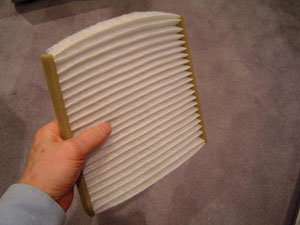 Cabin filters have been used on some on Audis and other European makes since the mid-1980s, and on a growing list of domestic makes since the mid-1990s. Today, close to 80 percent of all new vehicles have one of these filters — or a place where one can be installed. But it’s often called the “hidden filter” because many motorists don’t realize their vehicle has a separate air filter for the passenger compartment. Cabin air filters are put there for the health of the vehicle’s occupants.
Cabin filters have been used on some on Audis and other European makes since the mid-1980s, and on a growing list of domestic makes since the mid-1990s. Today, close to 80 percent of all new vehicles have one of these filters — or a place where one can be installed. But it’s often called the “hidden filter” because many motorists don’t realize their vehicle has a separate air filter for the passenger compartment. Cabin air filters are put there for the health of the vehicle’s occupants.
The best way to tell if a vehicle has a cabin air filter, or factory provisions for installing a cabin air filter, is to check the vehicle owner’s manual. Also check the catalog listings for cabin air filters by year, make and model.
If a vehicle has a cabin air filter, it will usually be located at the base of the windshield (open the hood and look in the cowl area for a small access door), or somewhere behind the glove box in the HVAC assembly (look under the dash for an access door). On some vehicles, the glove box has to be removed to access and replace the filter.
Most cabin air filters are flat panel filters, but some have unusual shapes so they will fit the HVAC inlet duct. Some may also be in two sections to make replacement easier. These filters can trap pollen, dust, smoke and other pollutants that would otherwise enter the vehicle and possibly irritate the nose and lungs of the driver and passengers.
Many motorists are not aware their vehicles have these filters. So ask your customers if they have checked their cabin air filters lately. It may stimulate some conversation as well as filter sales.
The service life of a cabin air filter depends on two things: the type of filter (dust or combination dust/odor) and operating conditions. A filter on a vehicle that is driven frequently on gravel roads will not have the life of a filter in a vehicle that is driven in a cleaner environment. Exposure to heavy traffic (especially diesel fumes) and urban pollution can also shorten the life of a combination dust/odor filter.
As a general rule, most cabin air filters should be changed every 20,000 to 30,000 miles — or more often depending on the size and capacity of the filter. Many vehicle manufacturers recommend replacing the filters every 12,000 to 15,000 miles or once a year. Refer to the vehicle owner’s manual for specific service interval recommendations.
Most of these filters are highly efficient and have electrostatically charged fibers that do an excellent job of trapping even the smallest particles (down to 0.3 microns!). Most cabin air filters will stop 100 percent of all particles that are 3 microns or larger in size, and 95 to 99 percent of particles in the 1- to 3-micron-size range.
Some cabin air filters also trap odors, and are called “combination” filters. These filters have an extra layer of activated carbon that reacts with odors and other airborne pollutants to neutralize them before they become objectionable. The filters can even reduce the levels of carbon monoxide and oxides of nitrogen from the exhaust of other vehicles.
The levels of these pollutants can be quite high in heavy stop-and-go traffic, and it’s not unusual for the concentration of these pollutants to be several times higher inside a vehicle than outside. Studies have shown that driver reaction times are slower when the driver is being affected by poor air quality.













